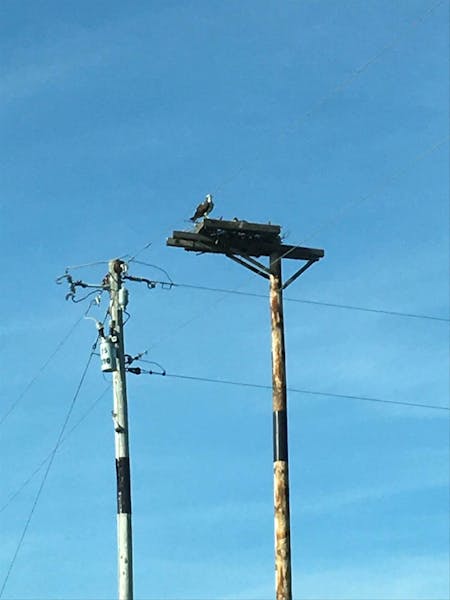Two young osprey flew out of Minnesota in early October near the tail end of fall migration for this species, a bit delayed because they'd spent part of the summer in a wildlife hospital. They were young males, hatched just last year, and had suffered injuries that landed them at the U of M's Raptor Center.
They'd been admitted last summer with injuries that interfered with their ability to fly. The Raptor Center has developed specialized expertise about these unusual hawks — they're often tough to maintain in captivity — and brought all its resources to bear to get them flying again.
The two osprey came to my attention near the end of their convalescence, as they were being "test flown" on tethers in a local park in early October. Checking in with Lori Arent, the assistant director of the Raptor Center, I learned more about rehabilitating these fishing hawks.
"Osprey are wired differently than other raptors, they're a bit high-strung, and they're not very patient," Arent said, calling them "one of the most challenging raptors to rehabilitate." Wonderfully adapted to the job of catching and holding fish in their long, curved talons, the birds need specialized caging in order to heal without damaging their feet, wings or tail feathers.
Osprey in captivity had been notorious for refusing to eat fish they hadn't caught themselves, thus didn't do well as patients, until a dedicated falconer developed a savvy way to get these hawks to resume eating.
The Raptor Center modified his technique, placing osprey patients in a dark room, then approaching from behind to drop fish pieces into their mouths, accompanied by a whistling sound as the bird swallowed. Soon, the birds would learn to associate the sound with the food, and would pick up and eat fish pieces themselves, and so a major hurdle was crossed.
It must have been so satisfying to drive the two young osprey in October to their release sites (one in Itasca County, the other along the St. Croix River) and watch them fly up and away on strong wings. Timing was important, because as the weather cools, fish move lower in waterways, out of reach of fish-hunting birds.
Osprey are becoming a familiar sight in the metro area once again, with many birds raising their young on nesting platforms, utility towers, ballfield lights, even water towers. In 2022, Three Rivers Park District volunteers counted 123 occupied osprey nests in the metro area, while another organization, Twin Cities Metro Osprey Watch, managed by Vanessa Greene, counted 167 occupied nests last year.
Steven Hogg, a wildlife biologist who manages Three Rivers' osprey monitoring effort, notes that their count probably includes about 60% of the nests in the eight-county metro area (some nests are very well hidden).
The positive trend in osprey nesting in the metro area is very good news: Sightings had become extremely rare by the 1960s as the birds' population plummeted due to loss of habitat and widespread use of the pesticide DDT. Three Rivers has been monitoring metro osprey since a reintroduction effort began in 1984 by relocating young birds from northern Minnesota.
Osprey spend several years in the tropics after their first autumn migration. "They return when they're 2 to 4 years of age, once they're sexually mature, and they nest in the same general area that they fledged from," Hogg says.
If you want to find nesting osprey this spring, Three Rivers' parks have a number of osprey towers, and your local ballfield may host one of their big stick nests on a light pole. Many osprey nests are found near waterways — I found three active nests last July at Rice Creek North Regional Park in Shoreview, all on nesting platforms.
It's a grand thing that humans are making concerted efforts to keep osprey in the metro area, because there are few sights more thrilling than watching one of these elegant raptors plunge into a river or lake, wings raked back, on a dive for a fish dinner.
If you find an injured raptor …
Call the Raptor Center (612-624-4745) before you act, advises Arent, to avoid injuries to yourself or the bird. The center has a large corps of volunteers across the state who will rescue and transport the birds. Visit the website for tips and what to do after hours (https://raptor.umn.edu/injured-bird/raptor-handling-tips). The Minnesota DNR maintains a list of wildlife rehabilitators by county: (https://files.dnr.state.mn.us/eco/nongame/rehabilitation/wildlife_rehabilitators.pdf).

The 5 best things our food writers ate this week

A Minnesota field guide to snow shovels: Which one's best?

Summer Camp Guide: Find your best ones here

Lowertown St. Paul losing another restaurant as Dark Horse announces closing

